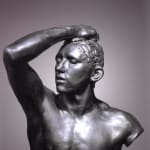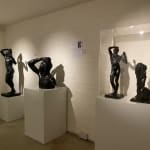Auguste Rodin French, 1840-1917
Further images
The Age of Bronze depicts the nude figure of a young man in a contemplative pose. The sculpture showcases Rodin's remarkable skill in capturing the human form with great anatomical accuracy and attention to detail. The figure is shown with his head slightly bowed and his arms crossed, exuding a sense of introspection and vulnerability.
The sculpture initially stirred controversy when it was first exhibited. The level of realism and the meticulous detailing of the figure led some critics to believe that Rodin had cast the sculpture from a live model, as opposed to sculpting it himself. The lifelike quality of the sculpture, particularly the delicate rendering of the figure's muscles and veins, added to this perception.
However, Rodin clarified that he did not use a live model for The Age of Bronze but instead employed various studies and his own observations of the human body. The controversy ultimately helped bring attention to Rodin's innovative approach to sculpting and contributed to his growing reputation as a sculptor of great talent.
The Age of Bronze marked a turning point in Rodin's career, as it brought him recognition and acclaim within the art world. It showcased his ability to create deeply expressive and naturalistic sculptures that conveyed a sense of emotional depth. The success of this work set the stage for Rodin's subsequent masterpieces and established him as one of the most influential sculptors of his time.






